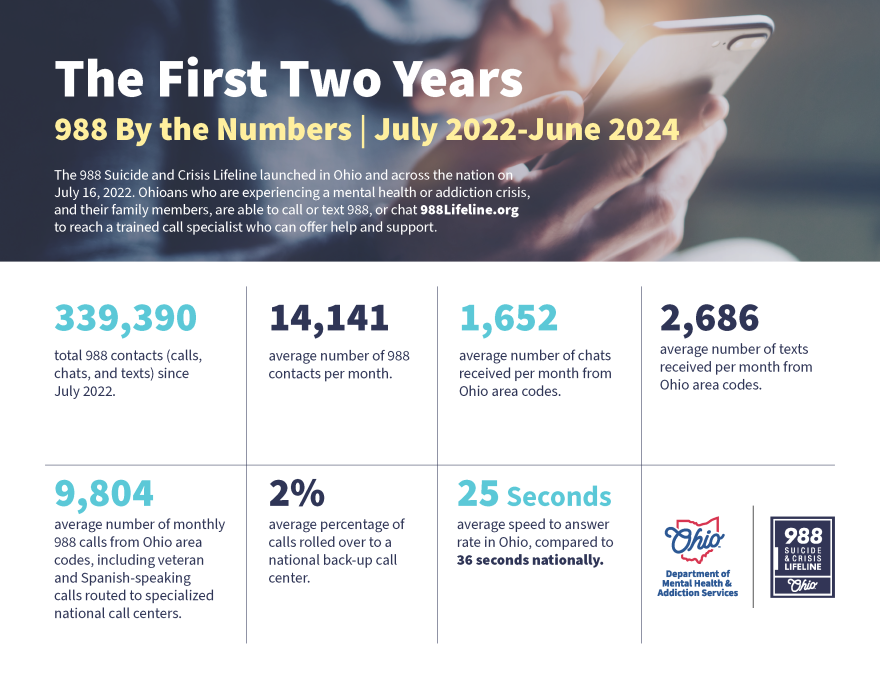No matter what time you call the 988 suicide prevention line, someone is there to answer. Today, James Reeves picks up the phone.
“Thank you for calling 988. Can I help you?,” Reeves said into his headset on an August day at the Talbert House, a crisis call center in Cincinnati.
Every conversation at the 988 call center starts this way, but there’s no script for what comes next.
Reeves talks to anonymous callers who are lonely, who feel hopeless or anxious. He talks to children who are being bullied at school, veterans experiencing post traumatic stress disorder and people seeking addiction treatment.
“We had one gal who was living in a tent in the woods with a brand new baby and didn't have anything,” Reeves said. “But every once in a while, she got to charge her phone, and she would text us, and she would talk to us about those things.”
"We’re that one more piece of light in the darkness that lets someone feel like it's all right."James Reeves, quality assurance administrator at the Talbert House
Two years ago, the national suicide prevention’s 10-digit hotline was shortened to just 988 – in hopes of making it easier to dial for help. Ohio enlisted 19 call centers across the state to answer the line, including the Talbert House, where Reeves works.
The line has received more than 300,000 calls, texts and chats from Ohioans since its launch.
Increasing awareness
The Talbert House, a southwest Ohio nonprofit providing social services, has manned its own local crisis line for decades. Since joining the 988 network, its call volume has doubled.
“Call volume is increasing year over year and month over month,” said Alex Rulon, director of the Cincinnati call center. “I think what that tells you is that people are using 988. They feel comfortable with 988 and they are happy with the customer experience.”
The increasing number of calls is a good sign, said Doug Jackson, the state’s 988 administrator. He said it’s happening all across the state. When the number first launched, Jackson said very few people had heard of the resource. Now, a little more than a third of Ohioans say they’re familiar with the crisis line.
“Just like 911, if you are traveling, if you move across state lines, the number remains the same wherever you're at. And it's easy to remember,” he said.

With more call centers than any other state, Ohio fields around 10,000 calls for help a month. 99% of them are answered by local Ohio operators like Reeves.
“Somebody who has the same geographic background, cultural backgrounds, community backgrounds, [who knows] the resources that are available if a referral is needed,” Jackson said. “So it's Ohioans taking care of Ohioans.”
Mental health need
The service has come at a crucial time. Suicide rates have increased in the last decade. Five Ohioans die by suicide each day. And a quarter of adult Ohioans report having been diagnosed with depression, according to the Health Policy Institute of Ohio (HPIO).
Yet, the 988 program doesn’t yet have a permanent source of funding. The legislature allocated millions in its budget toward the crisis line through next year. After that, it’ll need another boost.

Some states across the U.S. have looked to cell phone surcharges to fund their crisis line.
“It would just be adding a surcharge similar to 911 to create that steady stream of funding,” said Carrie Almasi, director of assessment and planning at the Health Policy Institute of Ohio.
Some Ohio legislators have pitched doing just that, but Jackson, the 988 administrator, said it’s still unclear how the line will be funded in the future. He’s confident, though, that the state will make it work.
Almasi said it’s just one of many mental health investments Ohio needs. She wants to see the state invest in the behavioral health workforce, mental health first aid and other services that can prevent Ohioans from hitting crisis levels.
“This intervention alone isn't going to solve the problem that leads to death by suicide in Ohio,” Almasi said. “We need to make sure that people have everything they need to be physically and mentally healthy in our state.”
Picking up the phone

In the meantime, operators like Reeves will keep picking up the phone. Some calls are just lending a listening ear. Other times, he said he stays on the line until mental health professionals can go to the site and intervene.
“When you get to the end of a 15 minute call or a three hour long phone call, and you come to a point where you feel like everyone's safe and they're saying, ‘I'm glad you're the one who answered the phone’,” Reeves said. “That's [the] reward.”
For every call like that, the staff here pins a feather to the wall. A flurry of them float above the operators’ desks – a reminder of the lives they’ve saved.
If you or someone you know may be considering suicide or is in crisis, call or text 988 to reach the Suicide & Crisis Lifeline.






